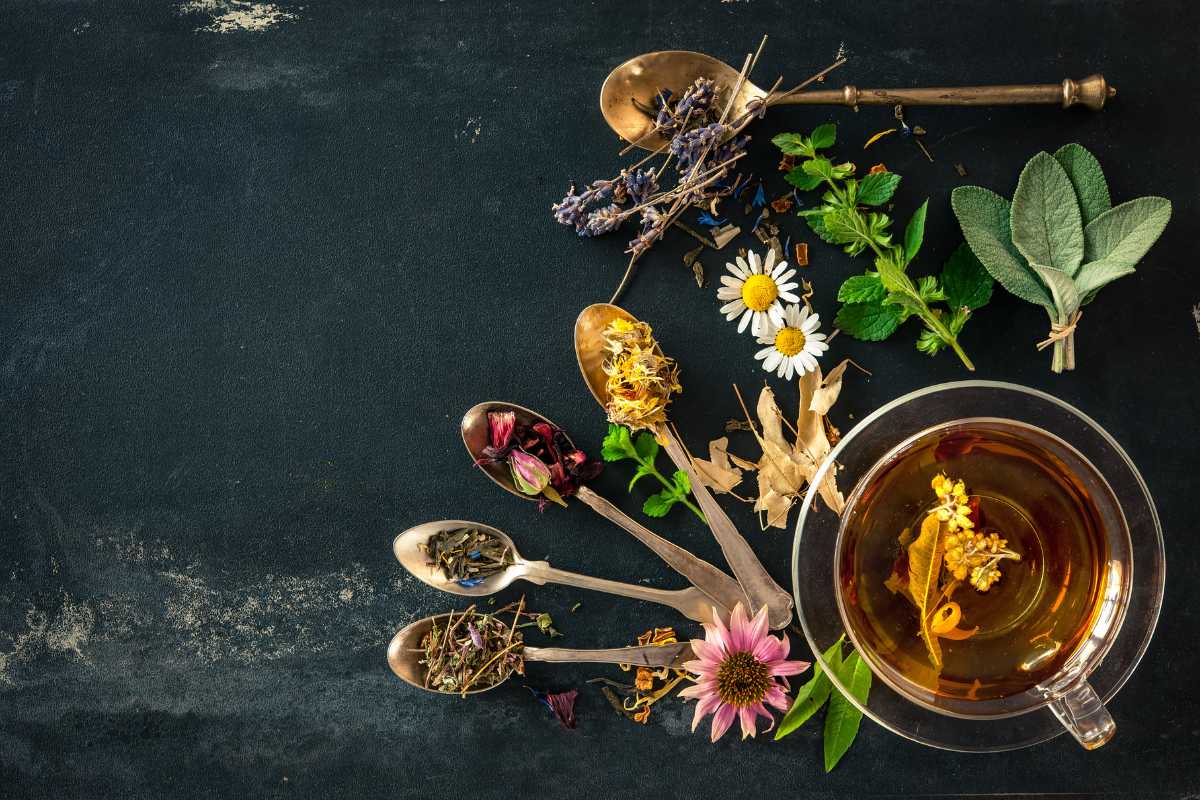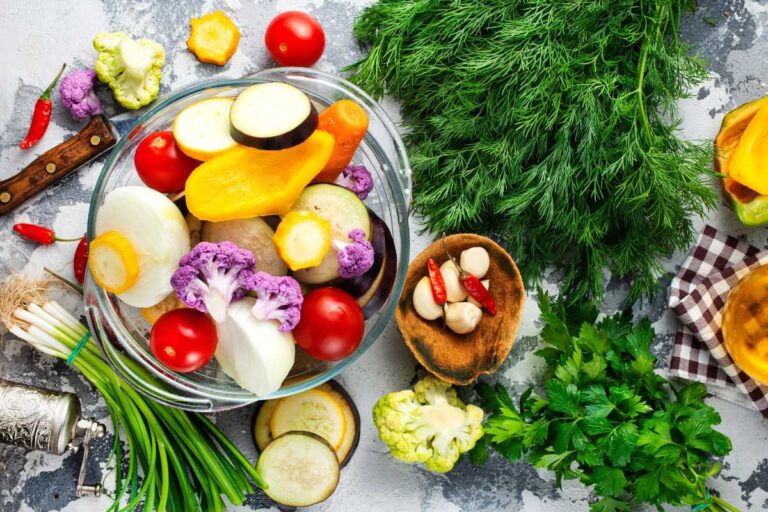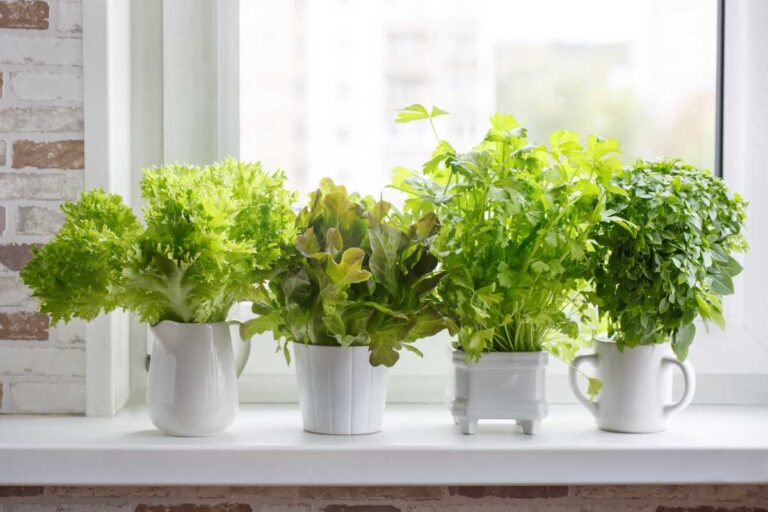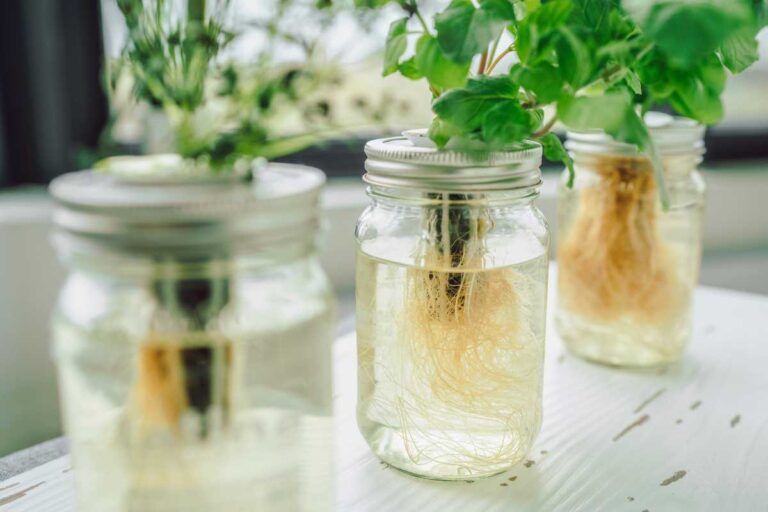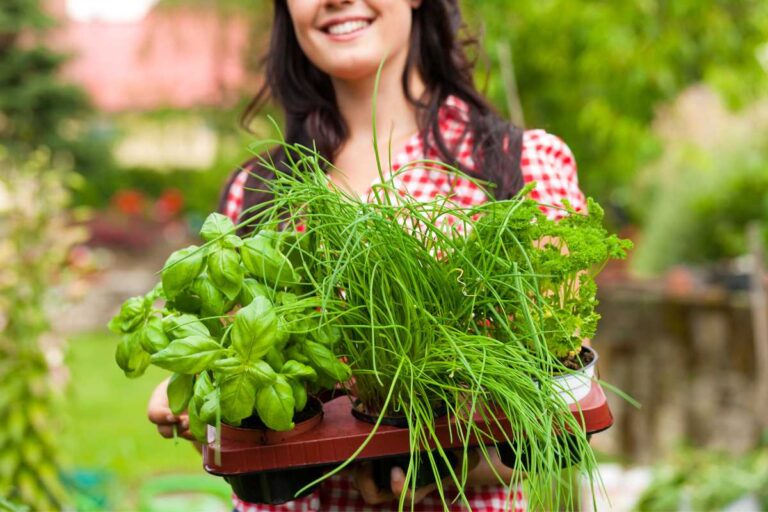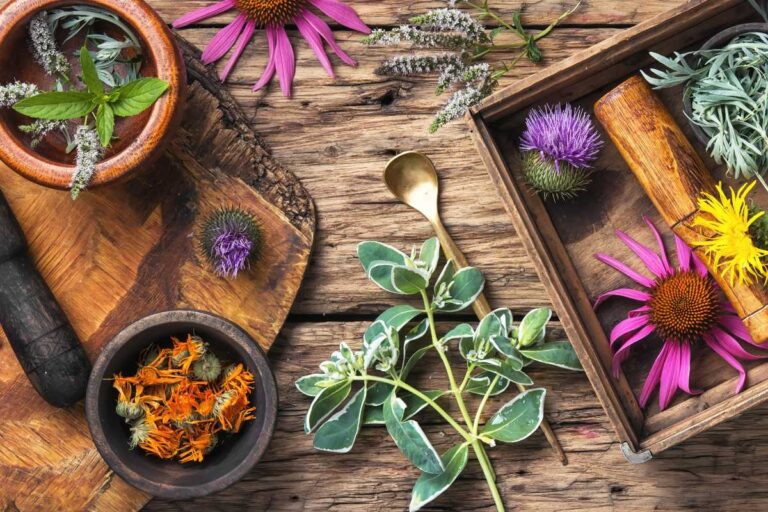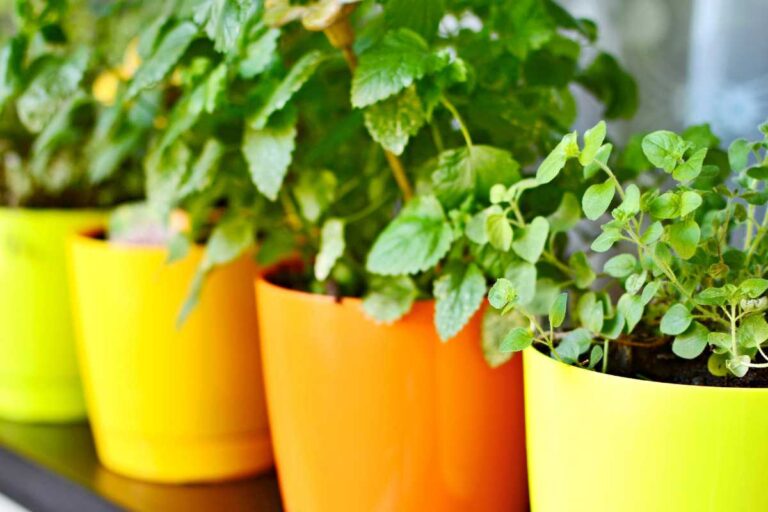What Are the Best Herbs to Grow for Tea? A Complete Guide to the Top 10 Tea Garden Herbs
What Are the Best Herbs to Grow for Tea? A Complete Guide to the Top 10 Tea Garden Herbs

Discover the world of herbal teas and their health benefits. Herbal teas have gained immense popularity due to their soothing flavors and potential wellness benefits.
Whether you’re a tea enthusiast or simply looking to explore new ways to enhance your well-being, understanding the different types of herbs used in tea blends is essential.
Herbal teas, also known as tisanes, are beverages made from the infusion or decoction of various plants, leaves, flowers, or even weeds.
Unlike traditional green tea derived from the Camellia sinensis plant, herbal teas encompass a wide range of botanical ingredients that offer unique flavors and therapeutic properties.
From calming chamomile to invigorating peppermint, each herb brings its distinct qualities to the cup. Some popular choices include rosehips with its tangy taste and rich vitamin C content, while lavender adds a floral aroma that promotes relaxation.
Exploring herbal teas allows you to tailor your beverage choices according to your preferences and specific health needs.
So why not dive into the world of herbal teas? Discovering these natural infusions can be an exciting journey towards enhancing your well-being while savoring delightful flavors.
| Herb | Who should drink it? | Short Explanation |
|---|---|---|
| Chamomile | Those with sleep issues | Chamomile is known for its calming properties and can help promote better sleep. |
| Peppermint | Those with digestive issues | Peppermint can help soothe an upset stomach and aid in digestion. |
| Lemon Balm | Those with anxiety | Lemon balm has a calming effect and can help reduce anxiety and stress. |
| Lavender | Those with stress | Lavender can promote relaxation and reduce stress levels. |
| Ginger | Those with nausea | Ginger can help alleviate nausea and aid in digestion. |
| Echinacea | Those with weakened immune systems | Echinacea can boost the immune system and help fight off infections. |
| Rosemary | Those with memory issues | Rosemary has been linked to improved memory and cognitive function. |
| Peppermint | Those with headaches | Peppermint has analgesic properties and can help relieve headaches. |
| Hibiscus | Those with high blood pressure | Hibiscus can help lower blood pressure and improve heart health. |
| Lemon Verbena | Those with digestive issues | Lemon verbena can help soothe the digestive system and improve digestion. |
Tired of struggling with outdoor herb gardens in unpredictable weather? Discover the secret to successful herbal gardening indoors and enjoy fresh herbs year-round. Check out our article now!
How to Grow a Tea Garden
Creating your own tea garden at home is a delightful and rewarding experience. Not only will you have access to fresh, aromatic herbs for brewing your favorite teas, but you’ll also enjoy the beauty and tranquility of a flourishing herbal tea garden. To help you get started, here are some expert tips on how to grow the best herbs for tea.
Ideal Growing Conditions for Herbs Used in Tea
To ensure that your herbal tea garden thrives, it’s crucial to provide the ideal growing conditions for your plants. Most herbs used in tea prefer full sun exposure, so choose a location in your garden that receives at least six hours of direct sunlight each day. Make sure the soil has good drainage to prevent waterlogging and root rot.
Consider planting directly in the ground or using raised garden beds. Raised beds offer better control over soil quality and moisture levels while minimizing weed growth. They also provide improved accessibility for maintenance tasks such as watering and harvesting.
Methods of Propagating and Caring for Tea Plants
Once you’ve chosen an appropriate location, it’s time to propagate and care for your tea plants. There are several methods you can use:
- Seeds: Some herbs used in tea can be grown from seeds. Start by sowing them indoors during late winter or early spring before transplanting them outside when all frost danger has passed.
- Cuttings: Another way to propagate tea plants is through cuttings. Take 4-6 inch stem cuttings from healthy plants, remove lower leaves, dip them into rooting hormone powder, and plant them in well-draining potting mix.
- Division: Certain herbs like mint can be divided into smaller clumps every few years during springtime.
- Transplants: If you prefer quicker results or want specific varieties, consider purchasing young tea plants from a local nursery or online.
To ensure your tea garden thrives, remember to provide regular care. Water your plants deeply but infrequently, allowing the soil to dry out slightly between waterings.
Apply organic mulch around the base of each plant to conserve moisture and suppress weed growth. Be vigilant for pests such as aphids or mites and take appropriate measures to control them.
Growing a Variety of Herbs in Your Tea Garden
One of the joys of having an herbal tea garden is the ability to grow a wide range of herbs with diverse flavors and aromas. Consider including some of these popular options in your garden:
- Peppermint: Known for its refreshing taste and soothing properties.
- Chamomile: A calming herb that promotes relaxation and aids sleep.
- Lemon Balm: Adds a delightful citrusy flavor to teas while also possessing calming effects.
- Lavender: Infuse your teas with its floral fragrance and potential stress-relieving benefits.
- Rosemary: Known for its invigorating scent, rosemary can add depth to herbal blends.
With these expert tips on creating an herbal tea garden, you’re well on your way to cultivating a haven of aromatic delights right in your backyard.
Enjoy experimenting with different combinations of herbs and discovering new flavors as you embark on this rewarding journey of growing your own tea ingredients.
Chamomile: Uplifting Aromatic Blend
Chamomile is a delightful herb that offers not only a soothing aroma but also numerous health benefits when used in tea. From its beautiful pink flowers to its gentle flavor, chamomile is a versatile herb that can be enjoyed on its own or as part of a blend.
Uncover the Soothing Properties of Chamomile in Tea
Chamomile has long been valued for its calming effects and is often used to promote relaxation and reduce stress. When brewed into tea, chamomile releases aromatic compounds that can help ease anxiety and improve sleep quality.
Its delicate floral notes create a sense of tranquility, making it an ideal choice for winding down after a long day.
Moreover, chamomile has been traditionally used to soothe coughs and alleviate symptoms of the common cold. Its natural anti-inflammatory properties can help relieve throat irritation and promote respiratory health.
By incorporating chamomile tea into your daily routine, you can experience the soothing benefits it offers.
Harvesting and Drying Chamomile Flowers for Brewing
Growing your own chamomile plants allows you to have access to fresh blooms whenever you desire. To harvest chamomile flowers for brewing tea, follow these simple steps:
- Identify fully opened flowers: Look for blossoms with vibrant yellow centers surrounded by white petals.
- Gently pluck the flowers: Carefully pinch off each flower head at the base of its stem.
- Rinse if necessary: If there is any dirt or debris on the flowers, rinse them gently under cool water.
- Dry the flowers: Spread out the freshly harvested flowers in a single layer on a clean towel or drying rack. Place them in a well-ventilated area away from direct sunlight.
- Allow the flowers to dry completely: This process can take up to two weeks, depending on the humidity levels in your environment. The flowers should feel dry and crumbly to the touch when ready.
Once dried, you can store the chamomile flowers in an airtight container for future use. When brewing tea, simply add a teaspoon or two of dried chamomile flowers per cup of boiling water and let it steep for 5-10 minutes. Enjoy the comforting aroma and delicate flavor that chamomile brings to your cup.
Discover Unique Flavor Combinations with Chamomile as a Base
Chamomile serves as an excellent base for creating delightful tea blends with other herbs and ingredients. Its mild flavor allows it to harmonize beautifully with various additions, offering endless possibilities for unique flavor combinations. Here are some exciting options to explore:
- Lavender Chamomile Blend: Combine dried chamomile flowers with lavender buds for a floral-infused tea that promotes relaxation and tranquility.
- Chocolate Mint Chamomile Blend: Add chocolate mint leaves to chamomile flowers for a refreshing and indulgent treat that satisfies both body and soul.
- Lemon Balm Chamomile Blend: Mix lemon balm leaves with chamomile flowers for a citrusy twist that uplifts your spirits.
Fennel: A Guide to Foeniculum Vulgare
Fennel tea is known for its distinct taste and aromatic properties. Made from the seeds of the fennel plant, it offers a delightful blend of flavors that can elevate your tea-drinking experience.
But fennel is not just about its taste; it also boasts numerous medicinal uses and potential health benefits. In this guide, we will dive into the world of fennel, exploring its unique qualities and ways to incorporate it into your daily tea routine.
The Distinct Taste and Aroma of Fennel Tea
When you sip a cup of fennel tea, you are immediately greeted by its enchanting flavor profile. The taste is often described as sweet and slightly licorice-like, with hints of citrusy undertones. This delightful combination makes fennel tea a refreshing choice for those seeking a unique beverage experience.
The aroma of fennel tea is equally captivating. As you brew the seeds in hot water, an inviting fragrance fills the air. It’s no wonder why many people find comfort in savoring a warm cup of fennel-infused goodness.
Medicinal Uses and Potential Health Benefits
Beyond its enticing taste and aroma, fennel has long been recognized for its medicinal properties. Traditional medicine often utilizes various parts of the plant to address different health concerns.
One notable benefit of fennel is its ability to aid digestion. Filled with natural compounds that promote healthy digestion, such as anethole, fenchone, and estragole, fennel can alleviate bloating, indigestion, and other digestive discomforts.
Moreover, studies suggest that consuming fennel tea may help manage menstrual symptoms like cramps and hormonal imbalances due to its estrogenic properties. Its soothing effects on muscle contractions make it a popular choice among women seeking relief during their menstrual cycles.
Creative Ways to Incorporate Fennel into Your Daily Tea Routine
If you’re ready to embark on a fennel tea adventure, there are numerous creative ways to enjoy its benefits. Here are some ideas to incorporate this herb into your daily routine:
- Plain and Simple: Start by brewing fennel seeds in hot water for a classic cup of fennel tea. Allow the flavors to infuse for a few minutes before savoring the aromatic delight.
- Blend it Up: Combine fennel seeds with other herbs like chamomile or mint for a unique blend of flavors. Experiment with different ratios until you find the perfect combination that suits your taste buds.
- Sweeten the Deal: Add a touch of sweetness to your fennel tea by stirring in honey or a sprinkle of cinnamon. This can enhance the overall experience and provide an extra layer of indulgence.
- Iced Fennel Tea: During warmer months, cool down with a refreshing glass of iced fennel tea. Simply brew the tea as usual, let it chill, and serve over ice cubes for a revitalizing summer beverage.
Stevia: The Sweet Herb for Tea
Stevia leaves offer a delightful and all-natural alternative sweetener that can transform your tea-drinking experience. Not only does stevia add a touch of sweetness to your favorite herbal blends, but it also comes with several health benefits.
Discover an all-natural alternative sweetener with stevia leaves
Look no further than stevia. Derived from the Stevia rebaudiana plant, this sweet herb offers an intense burst of sweetness without the added calories or negative effects on blood sugar levels. Stevia is incredibly potent; just a small amount of its dried leaves or liquid extract can replace a significant amount of sugar.
Learn how to cultivate stevia plants and harvest their leaves for sweetness
Growing your own stevia plants is not only rewarding but also ensures you have access to fresh leaves whenever you desire. To cultivate these delightful herbs:
- Choose the right location: Stevia thrives in warm climates with plenty of sunlight.
- Prepare the soil: Ensure well-draining soil enriched with organic matter.
- Sow the seeds: Plant the seeds indoors about 8-10 weeks before the last frost date.
- Transplanting: Once seedlings have developed at least two sets of true leaves, transplant them into larger pots or directly into your garden.
- Watering and care: Keep the soil moist but avoid overwatering to prevent root rot.
- Harvesting: When the plant reaches about eight inches tall, harvest individual leaves by pinching them off near their base.
Explore the versatility of stevia in various herbal tea recipes
Stevia’s sweet taste makes it an excellent addition to a wide range of herbal tea recipes. Whether you prefer a soothing tisane for relaxation or a refreshing blend to quench your thirst, stevia can enhance the flavor profile and provide that perfect touch of sweetness. Here are some ideas to get you started:
- Peppermint and Stevia: Combine fresh peppermint leaves with stevia for a delightful minty sweetness.
- Chamomile and Stevia: Add stevia leaves to chamomile tea for a calming brew with a hint of honey-like sweetness.
- Ginger and Stevia: Infuse ginger slices with stevia leaves in hot water for a soothing drink that aids digestion.
- Lemon Balm and Stevia: Blend lemon balm leaves with stevia to create a citrusy, sweet infusion.
Stevia also offers potential health benefits, such as aiding in weight management, reducing blood pressure, alleviating sore throat symptoms, and promoting healthy skin. With its versatility and natural sweetness, this herb is truly a gem in the world of herbal teas.
Ginger: All You Need to Know
Unlock the invigorating flavors and warming effects of ginger tea. Ginger, with its distinctive taste and aroma, is a versatile herb that has been used for centuries in various culinary and medicinal applications. Not only does it add a unique flavor to dishes, but it also offers numerous health benefits.
Ginger is derived from the roots of the Zingiber officinale plant and has long been recognized for its positive impact on digestion. The active compounds found in ginger help stimulate the production of digestive enzymes, aiding in better nutrient absorption and reducing gastrointestinal discomfort.
If you often experience digestive disorders such as bloating or indigestion, incorporating ginger tea into your routine may provide relief.
Apart from promoting healthy digestion, ginger offers a range of other health benefits. Its potent anti-inflammatory properties can help alleviate symptoms associated with conditions like arthritis or muscle soreness.
Ginger has been shown to boost the immune system by enhancing the activity of certain immune cells, making it an excellent choice during cold seasons or when you need an extra immunity boost.
Growing your own ginger indoors is not only rewarding but also allows for easy access whenever you need it. To start growing ginger at home, look for fresh ginger root at your local grocery store or farmers’ market. Choose a piece that appears plump and firm with well-developed “eyes” (buds).
To grow ginger indoors:
- Fill a pot with well-draining soil.
- Plant the ginger rhizome horizontally with the buds facing up.
- Cover it lightly with soil and water gently.
- Place the pot in a warm spot that receives indirect sunlight.
- Keep the soil moist but avoid overwatering.
Within a few weeks, you will start to see shoots emerging from the soil. Ginger plants require a bit of patience, as they take several months to mature fully. Once your ginger plant reaches the end of its growth cycle, you can harvest the roots by gently digging them out of the soil.
To store ginger for future use, wash and dry the roots thoroughly, then place them in a paper bag or airtight container. Store them in a cool and dark spot to maintain their freshness.
Now that you have your own homegrown ginger at hand, there are endless possibilities for incorporating it into various tea blends or recipes.
Combine it with other herbs like lemon verbena or mint for a refreshing and aromatic infusion. For an extra kick, add a slice of fresh ginger to your favorite black or green tea.
Marjoram: Versatile Herb for Tea
Marjoram, an aromatic herb known for its delicate yet distinctive flavor profile, is a wonderful addition to any tea blend. This versatile herb not only adds a unique taste to teas but also offers various health benefits. Let’s delve into the world of marjoram and explore why it deserves a place in your tea collection.
Delve into marjoram’s delicate yet distinctive flavor profile in teas.
Marjoram reigns supreme. Its subtle floral notes with hints of citrus and pine make it an excellent choice for those seeking a refreshing and soothing beverage. The lemony undertones add a touch of brightness, enhancing the overall taste experience.
Marjoram pairs exceptionally well with other herbs, allowing you to experiment with different combinations and create your own signature blends. For instance, combining marjoram with rosemary can result in a robust herbal infusion that invigorates both the body and mind.
Alternatively, blending marjoram with mojito mint and horehound creates a delightful concoction that aids digestion while providing a minty freshness.
Explore its traditional uses in promoting relaxation and reducing stress levels.
For centuries, marjoram has been revered for its calming properties. It has long been used as an herbal remedy to promote relaxation and reduce stress levels. Sipping on marjoram tea after a long day can help unwind and ease tension, allowing you to find solace amidst life’s chaos.
Furthermore, marjoram is believed to possess medicinal properties that aid in alleviating common ailments such as headaches and insomnia. Its soothing effects on the nervous system make it an ideal choice for those seeking natural remedies for anxiety or sleep disturbances.
Learn how marjoram can complement other herbs when blended together.
One of the greatest joys of exploring herbal teas is discovering how different herbs harmonize when combined. Marjoram, with its versatile flavor profile, can play a supporting role in various tea blends.
When paired with spearmint, marjoram adds a subtle depth to the minty freshness, creating a well-rounded infusion. Similarly, blending marjoram with mentha and verbena results in a soothing cup of tea that aids digestion while providing a gentle citrus aroma.
Another delightful combination is marjoram and peppermint. The cooling properties of peppermint complement the floral notes of marjoram, resulting in a refreshing and invigorating beverage. The addition of borage or sage to this blend can enhance its therapeutic benefits.
Exploring the Best Herbs for Tea
We discussed how to grow a tea garden and provided detailed information on specific herbs such as Chamomile, Fennel, Stevia, Ginger, and Marjoram. Each herb brings its unique flavor and benefits to the world of tea.
Now that you have a better understanding of these herbs, it’s time to start planning your own tea garden! Whether you’re a seasoned gardener or just starting out, growing your own herbs for tea can be a rewarding experience.
Not only will you have access to fresh and flavorful ingredients for your teas, but you’ll also have the satisfaction of nurturing your plants from seed to cup.
So why not embark on this herbal journey and create your very own oasis of flavors? Start by selecting the herbs that resonate with your taste preferences and gardening abilities.
With proper care and attention, you’ll soon be enjoying delicious cups of homemade herbal tea straight from your garden.
FAQs
How often should I water my tea garden?
It is essential to keep your tea garden adequately hydrated. Generally speaking, most herbs prefer well-drained soil rather than being overly saturated. As a rule of thumb, aim to water your tea garden once or twice a week during dry periods or when the top inch of soil feels dry to touch.
Can I grow these herbs indoors?
Yes! Many of these herbs can thrive indoors if provided with sufficient sunlight and proper care. Choose a sunny spot near a window where they can receive at least six hours of sunlight each day. Make sure to monitor humidity levels and provide adequate ventilation to prevent mold or mildew growth.
How long does it take for these herbs to mature?
The time it takes for these herbs to reach maturity varies depending on the specific herb and growing conditions. Generally, you can expect most herbs to be ready for harvesting within 60-90 days after planting. However, some herbs like ginger may take longer to reach maturity.
Can I use dried herbs for tea instead of fresh ones?
Absolutely! Dried herbs can be a convenient alternative to fresh ones, especially during the winter months when fresh herbs may not be readily available. Simply harvest your herbs at their peak freshness and dry them in a well-ventilated area away from direct sunlight. Once dried, store them in airtight containers for future use.
Are these herbs safe for consumption?
Yes, the herbs discussed in this blog post are generally safe for consumption when used in moderation. However, it is always recommended to consult with a healthcare professional if you have any specific health concerns or are taking medication that may interact with certain herbs.

